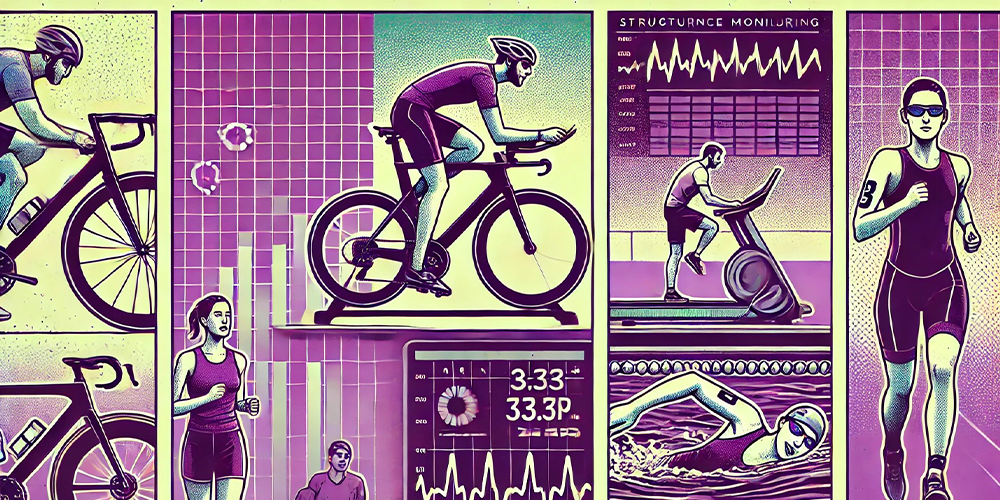The aim of training is to improve performance. 2PEAK offers you several simple but effective methods to measure your fitness level under real conditions, to be repeated as often as necessary. Here is an overview of the main performance tests offered by 2PEAK for cycling, running and swimming.
When you find the Performance Test icon on your training plan, keep in mind that this is the ideal time to test your physical fitness in your respective sport.
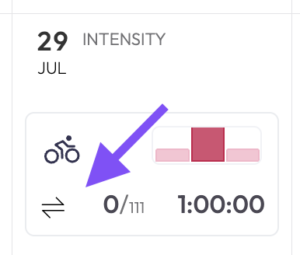
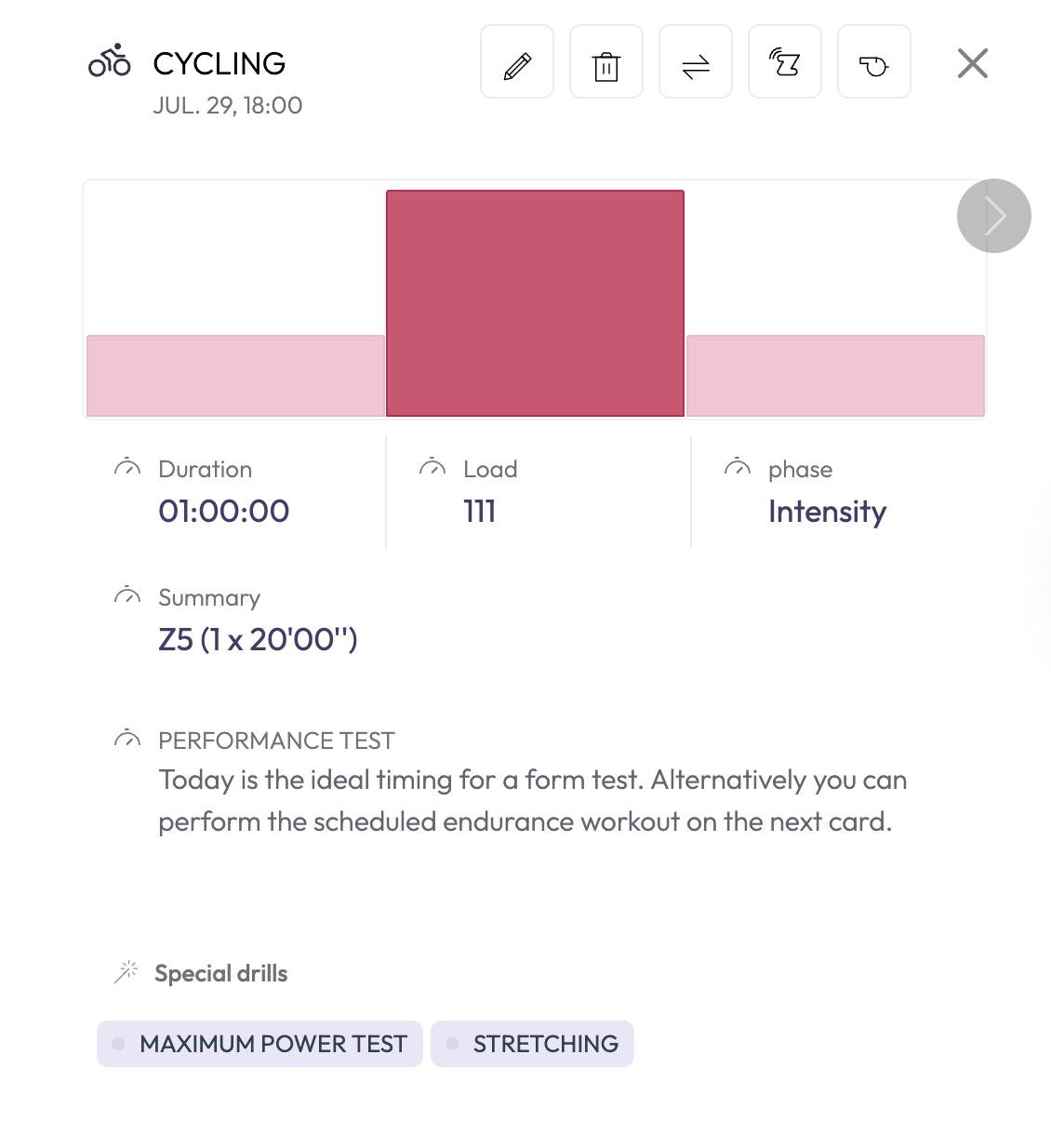
These tests should be done at regular intervals. The test will replace all the intervals scheduled for that day. It is then up to you to decide if you want to do one of our tests, an outside provider’s test, or your scheduled workout. 2PEAK algorithms are able to detect your current performance all the time, also without specific performance tests. However, through performance diagnostics, you can get even more detailed and customized data and statistics.
Let’s now look closely at the different tests for 2PEAK’s main sports, i.e. cycling, running and swimming. You will find them in the main menu in the top left-hand corner, under ‘Goals’ and then ‘Performance Tests’.
Cycling
MP Test (Maximum Power)
The Maximum Power (MP) test is used to check your maximum performance during an effort of 20 seconds, 1, 2, 4, 8, 16, 20 and 32 minutes (MP 0.3 up to MP 32) to chart your personal evolution. The test should preferably be performed in a resting state after a regeneration phase.
Depending on your personal goals, 2PEAK will define the most suitable type of test. In practice, MP tests lasting longer than 4 minutes (better is 8 minutes and more) can be used to determine and evaluate training zones. Short tests are used to test anaerobic abilities (sprinter, cross, MTB cross country, criterium), while long tests are used to determine hill or time trial capacities.
The MP test is run on inclines of at least 7 percent so that power can essentially be determined by lift work. To determine the distance, you need an accurate altimeter, or precise altitude data from GPS maps, a stopwatch and a speedometer. Choose the distance so that the route time corresponds approximately to the times indicated above. 2PEAK will mathematically adjust any variations or deviations. Choose clearly visible points for the start and finish line or mark the start and finish points on the route before starting the test lap. To determine aerobic capacity, the test time should be at least 4 minutes, preferably 8 minutes. For a 4-minute test, depending on pace, you need to cover approximately 70-140 metres (230-460 feet) of altitude difference. Alternatively, MP tests can be run on any route using power meters.
Warm up for 20 minutes at the upper range of your basic endurance (zone 2). After the warm-up you set off from the starting line with a flying start. Ride smoothly and as fast as you can. Write down your time as soon as you cross the finish line. In uphill sprints ask a friend for assistance to stop the time.
From the difference between start and finish altitude, your EXACT total weight (clothing, contents of water bottles, etc.), as well as distance and time, you can determine power very accurately. The lower the average speed, the better the accuracy of the measurement. Divide the weight into body weight and bike + clothing and accessories. This way, the related value of watts/kg body weight is always correct and is not falsified by thick winter clothing.
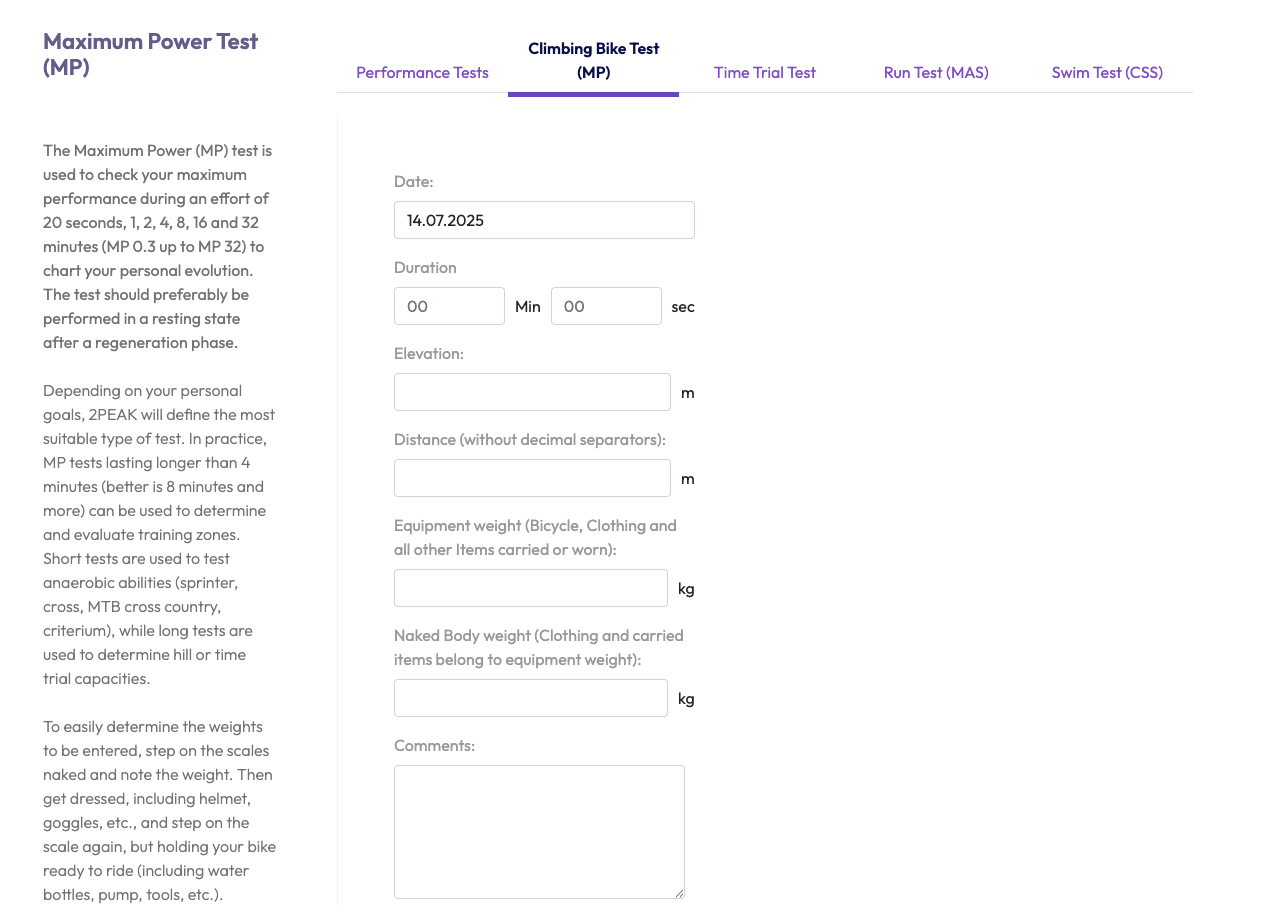
If you work out on a stationary bike with power meter, you can enter the MP values from here using average power and duration (at least 6 minutes) in a maximal power test.
For more information on power and why it is the best measure for analyzing training success, check out our article.
You may also be interested to find out what critical power is in cycling and what to keep in mind when training in power zone 5.
Time Trial Test
The Time Trial Test simulates a real-world time trial. It helps determine your power or heart rate at the anaerobic threshold, which is the highest intensity you can sustain consistently.
How to perform the test:
- Choose a flat or slightly rolling route with no interruptions where you can ride nonstop for 20 to 30 minutes.
- Warm up for 20 minutes, gradually increasing intensity to the top of zone 2.
- Start the test and ride for 20–30 minutes at the highest steady effort you can maintain.
- After finishing, record your average power (if using a power meter) or average heart rate (if using a heart rate monitor).
- If you enter your body weight, your power-to-weight ratio will be calculated, useful for comparing with climbs or races.
Tip: Weigh yourself first without gear, then again with your full kit and bike. The difference is your equipment weight.
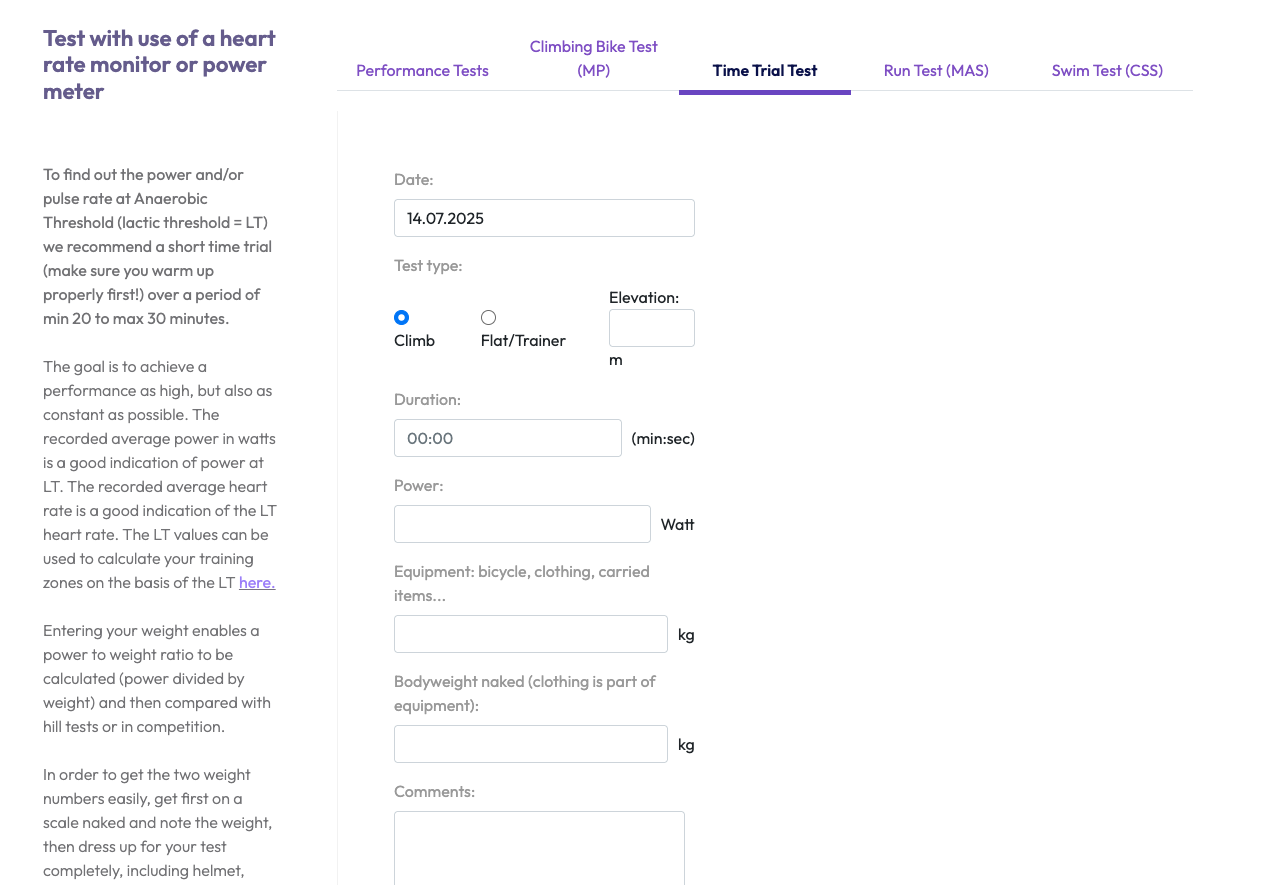
Running
MAS Test (Maximum Aerobic Speed)
With the MAS test you can establish and periodically adjust your training zones defined in heart rate and speed, as well as estimate your expected times for selected races.
Warm up carefully, for at least 20 minutes. Set your stopwatch and prepare to run 2000m. If you manage to run 2000m under 7:30, switch (next time) to 3000m. Ideally, you should run on a 400m track, but a flat road will also do as long as you can somehow measure and mark 2000 (or 3000) metres. Try to run evenly and start the first few laps at 90% of what you consider your maximum speed and only push to 100% on the last lap.
Caution: on the last lap you should run at a higher speed (or at the limit, the same) than on the previous laps. Note down your maximum heart rate at the end of the test or enter the maximum value stored by the heart rate monitor in the corresponding field.
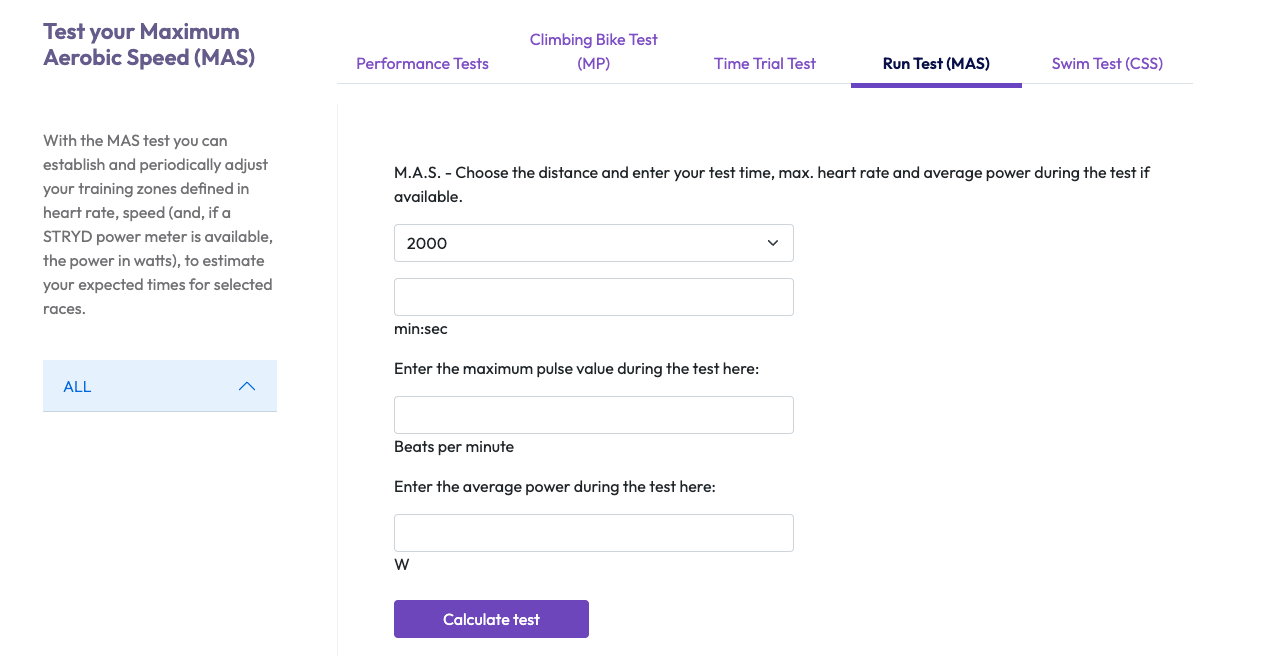
Swimming
CSS Test (Critical Swim Speed)
Triathletes usually compete over longer swim distances, so fatigue resistance during the swim is the critical variable. This “threshold performance” is called CSS or “Critical Swim Speed” and is defined by a simple test that can also be used to measure progress. CSS is the pace at which you’d currently swim a 1500 Time Trial (in yards or metres).
Warm up well including a couple of fast lanes to get used to the higher speeds. Then swim 400m to the maximum of your ability and note the time. Rest well (about 10 minutes) and repeat the 200m half distance test. Both tests should be performed without diving, but starting in the water and pushing yourself hard off the wall. Try to swim each of the laps at a constant speed with the aim of being really exhausted at the end!
Now go to the swimming test page. By entering the two times obtained in the table, your CSS is calculated and from there your swimming training zones based on pace.
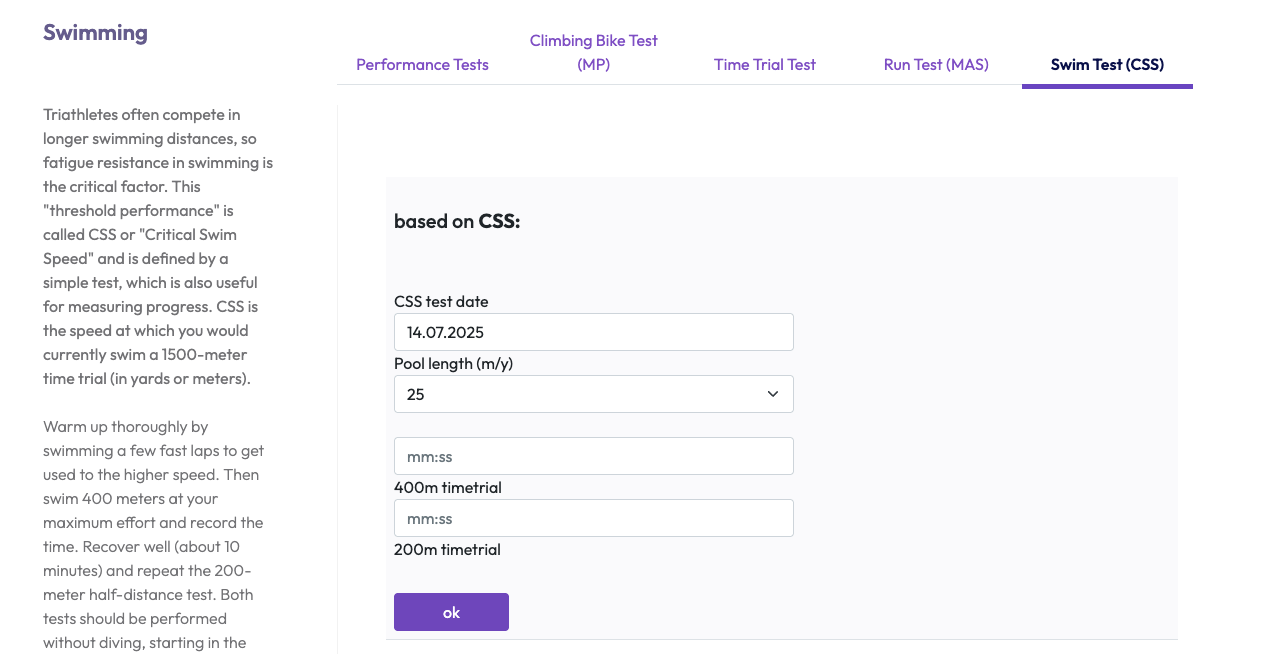
It is not so much the absolute times that are important, but rather the drop in speed over the longer distance. The goal is not to exceed a 4% drop. If, for example, both swim times improve, but the time drop increases, then the CSS will also increase, because this would mean that on 1500m or even 3800m the times would drop even more. The plan in this case would be to counteract this and schedule slower workouts until the fatigue resistance increases and thus the CSS becomes smaller.
If you have a strong push at the edge of the pool, it is worth repeating the test when you move from the 25-metre pool to the 50-metre pool, because the times are generally a little higher over the longer distance.
